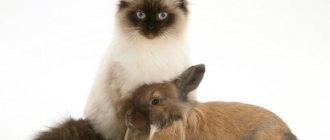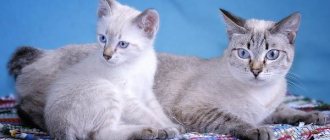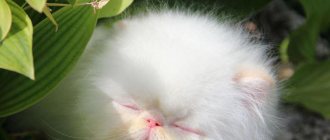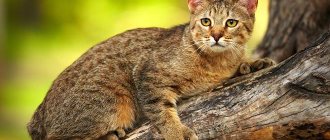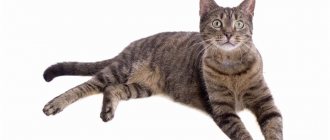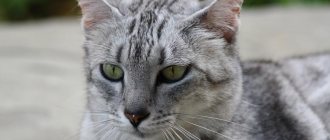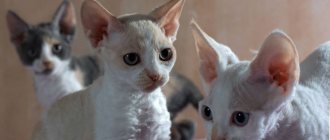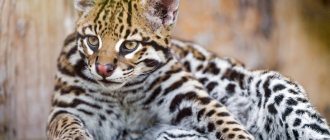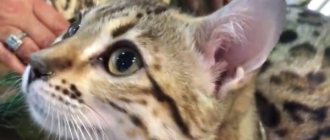Description and features of the wild tiger cat
Oncilla is a tiger cat that lives in the wild. It is much larger than a domestic cat, but the smallest among other wild cats. Oncillas most often have yellow-gray fur with tiger stripes. These cats are not afraid of water and swim well, although not so often.
The wild tiger cat (oncilla) resembles a miniature jaguar. Its coat is short and has characteristic stripes. These stripes on the body consist of individual spots closed in rings.
They clearly go in rows and do not break into separate spots. The stripes on the tail at first simply follow lines of spots, and then these lines connect to the end of the tail, forming rings.
Pictured is a tiger cat Oncilla
Oncilla has several subspecies that differ slightly in color. It is quite rare, although it lives in many places. In the last century, it was hunted for its valuable fur. Its population decreases every year due to deforestation.
The Australian tiger cat is quite unpretentious. It feeds on various small animals and sometimes attacks domestic chickens. In her pouch she carries newborn cubs, of which there can be more than ten.
Character
Toygers are moderately active cats. Calm by nature, they are friendly but not intrusive. Smart and intelligent, no whims or unreasonable screams or begging for food. Curious and smart. They quickly learn commands such as “no”, “bring”.
Sociable with hosts and guests, not cowardly. Jealousy is not inherent in them - they calmly treat other animals in the house and are friends with them.
Toyger owners talk about the extraordinary affection of this breed. This is true. Toy does not like to be alone for a long time; he definitely needs someone nearby. The cat does not require attention, is self-sufficient, but will never be against stroking.
They do not like enclosed spaces: they may become “indignant” when transported in a carrier, and become agitated in a car.
Breeds of cats with brindle color
In fact, brindle stripes (brindle tabby) are present in almost all cats; they are only noticeable to the human eye in a few breeds. The tiger cat of the Toyger breed is one of the youngest.
The photo shows a tiger cat of the Toyger breed.
Translated from English, toyger is a toy tiger. The Toyger is one of the most exotic and expensive breeds in the world. Her brindle coloring is certainly a delight. Such a cat gives a special chic to the house where she lives and is a sign of the wealth of its owners.
Some call them tigers, which is incorrect and distorts the meaning of the word. A Toyger is nothing more than a cross between a regular cat and a Bengal cat.
However, in appearance it looks like a real tiger, only several times reduced in size. The graceful, aristocratic appearance of brindle cats finally took shape in 2007, after a long search for ideal parents.
If you look at photos of brindle cats , you will notice that they have a rather curious body structure. They are large, weighing up to 6–8 kg, with a long thin tail and small paws.
Their muzzle is elongated and has a wide nose that is unusual for cats. Also, toygers have a powerful neck, with standard ears and large blue eyes. Although selectors at this stage of time are working on making the eyes smaller and the ears smaller. They want to give the ears a more rounded shape.
The tiger cat in the photo looks exactly the same as in life. Its color really exactly matches that of a tiger. Tiger stripes come in both black and brown, and even auburn. The coat is short and smooth. Its paws and the tip of its tail are black, and in addition to the stripes, there are spots and rosettes on the body and muzzle.
The domestic toyger is unusually calm and affectionate. He doesn't need much attention. In addition to the usual language for cats, toygers make other sounds similar to those of birds. Kittens are playful and active, like other breeds. Adult cats are loyal and intelligent.
The American Shorthair cat has been known since the beginning of the 20th century. She is quite peaceful and is a real long-liver among cats. Its lifespan can reach 20 years. Her tiger stripes come in a variety of colors.
The short-legged munchkin is one of the most mischievous breeds among brindle cats. Its fur is short and thick, and can be of absolutely any color, but with a tiger pattern. The breed appeared in 1991 and is distinguished by very short legs. These cats are more like dachshunds.
In the photo there is a munchkin cat of brindle color
The Siberian cat also became popular at the end of the last century. She is in no way inferior in devotion to dogs. Its fur is medium length and its weight can reach 12 kg.
The British tiger cat is known for its special character. If you don't raise her as a child, she will only do what she wants. She needs a lot of personal space and a place to retire. Its coat is quite short and its brindle coloration comes in different variations. The British are a bit like the Cheshire Cat from a fairy tale.
In the photo there is a kitten of the British brindle breed
The Scottish tiger cat has a marble tabby color on the back and dense wide stripes on the tail. On their head they have a characteristic marking in the form of the letter “M” in the same color as the pattern on their body. Their eyes are large and yellow, and their ears are smaller than other breeds.
The photo shows a Scottish tiger cat kitten
How to raise a pet tiger cub
Toyger kittens are born extremely smart. They are unusually attached to their owner and have a hard time withstanding separation. Little “tiger cubs” are playful and frisky; they play with children with pleasure, without trying to let out their claws.
High intelligence contributes to the rapid learning of the kitten. Toygers have no problems learning to use a tray or scratching post. Kittens are not afraid of water; they enjoy playing with streams of water and swimming.
Caring for the fur is simple - you don’t need to wash it with shampoo often, but you can let your cat frolic in the bath regularly.
Cats do not have any special health problems. True, like true tigers, they are fearless and often forget to be careful, so you should not keep the windows open in an apartment located on a high floor if a toyger lives in it.
It is important to provide your cat with a healthy, balanced diet, since even with high activity, Toygers are prone to obesity.
Note!
Singapore cat: character, photo, price, breed description, reviews, how to buy, how to choose, maintenance, care and owner reviews
Scottish Straight: cat photo, kitten prices, breed description, character, reviews, maintenance and care, nutrition + interesting facts
Chausie - overview of the breed, character and breeding characteristics. Price for a kitten and tips for choosing a purebred cat (115 photos)
Toygers love to meow. And they do it when they want. The range of their voice is wide: from high melodic trills to loud insistent meows. The cat doesn’t need anything - he just got bored.
Therefore, before asking how much a toyger costs and where to buy one, get ready to be woken up in the middle of the night by the loud voice of a striped pet.
Reproduction and lifespan
There is currently no information on how oncillas reproduce. They are monitored only in inanimate nature. A cat gives birth to no more than two kittens at a time. She carries them for almost three months. In the wild, oncilla can live no more than 15 years. In captivity, its life expectancy is 20 years.
In the photo there is a tiger kitten
Health
Typically, wild-type animals are very resilient and disease-resistant, unlike their bred counterparts. Modern genetic studies have shown that the T gene, which determines the brindle color, is directly related to immunity.
Artificially created breeds, more than the descendants of their “wild” counterparts, are susceptible to diseases such as:
- cardiomyopathy;
- cardiac hypotrophy;
- cataract;
- feline leukemia.
The rest of the “tiger cubs” mostly suffer only from the same diseases that ordinary domestic cats suffer from:
Prices for cats with brindle color
Spayed or neutered toygers cost 1–2 thousand dollars. The price of a tiger cat, which can produce offspring twice as large. These are some of the most expensive breeds in the world. A fold-eared tiger cat of the Scottish breed costs about 25 thousand rubles. She has a rather calm and good-natured character.
British tabbies are much cheaper - up to 10 thousand rubles. If, of course, there is a desire to purchase a kitten from parents who have a title and a good pedigree, then it will cost 30 thousand rubles. A short-legged munchkin can be purchased from 5 to 20 thousand rubles.
Nutrition
The daily diet of a wild cat should include:
- meat, preferably fresh beef;
- mineral supplements;
- vitamins.
Feeding occurs once a day. Once a week there is a fasting fasting day. To keep the animal healthy, a schedule of maintenance, nutrition, and observation by a veterinarian is drawn up.
The tiger cat is a very rare species, so it can only be purchased by pre-order. Kittens are expensive. The cost depends on the subspecies of the animal, the color of the fur and the pattern on it. You can find out the price of the animal at the nursery; the kittens are raised there under the supervision of specialists, vaccinated, and passports are made for them.
Breeding
Toygers are a healthy breed. Cats are capable of bearing full-fledged offspring and lambing on their own. They reach sexual maturity by six months, but they can be considered fully developed no earlier than two years of age. It is at this time that you can think about mating.
Both partners are first subjected to antiparasitic treatment. Be sure to check whether all scheduled vaccinations are up to date. Pregnancy in Toygers lasts from 55 to 65 days. Throughout its entire duration, you must systematically visit the veterinarian to examine your pet. Typically, a cat gives birth to two to six kittens.
Since the breed is still developing, it is not prohibited to cross Toygers with representatives of other breeds that have the characteristic features of the standard of a particular nursery. More often, a couple is selected abroad and from there delivered to Russia.
Brief historical background
The breed was bred in the USA at the end of the 20th century by Judy Sugden. An American breeder admired the predatory beauty of tigers and therefore was inspired by the idea of breeding a cat whose appearance would be similar to that of a tiger.
She brought the founder of the breed from India. He became a street Bengal cat. Sugden crossed him with a Bengal cat from her mother's cattery.
The result was kittens with characteristic stripes, which made them look similar to tiger cubs. Already in this century, the toyger received exhibition rights.
